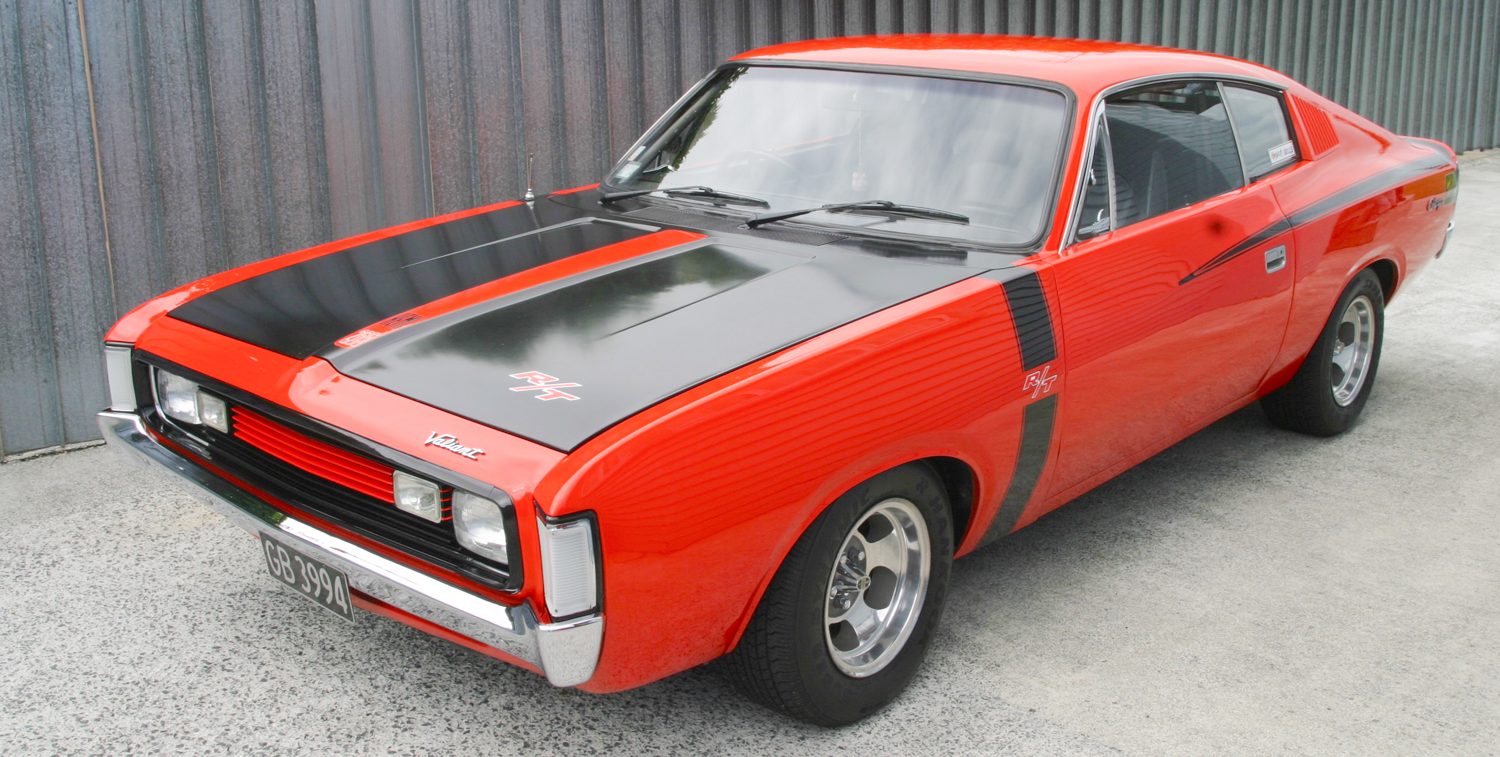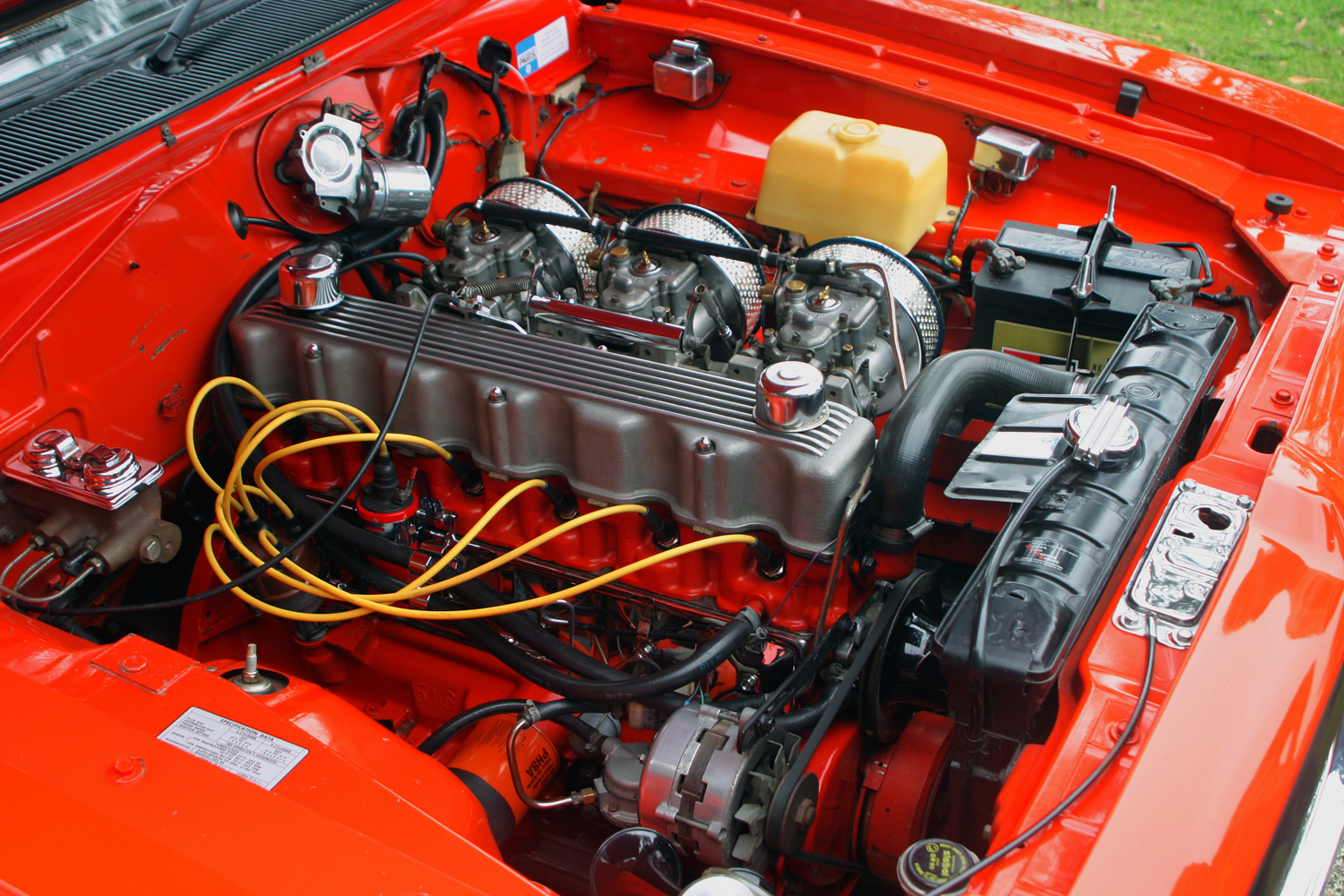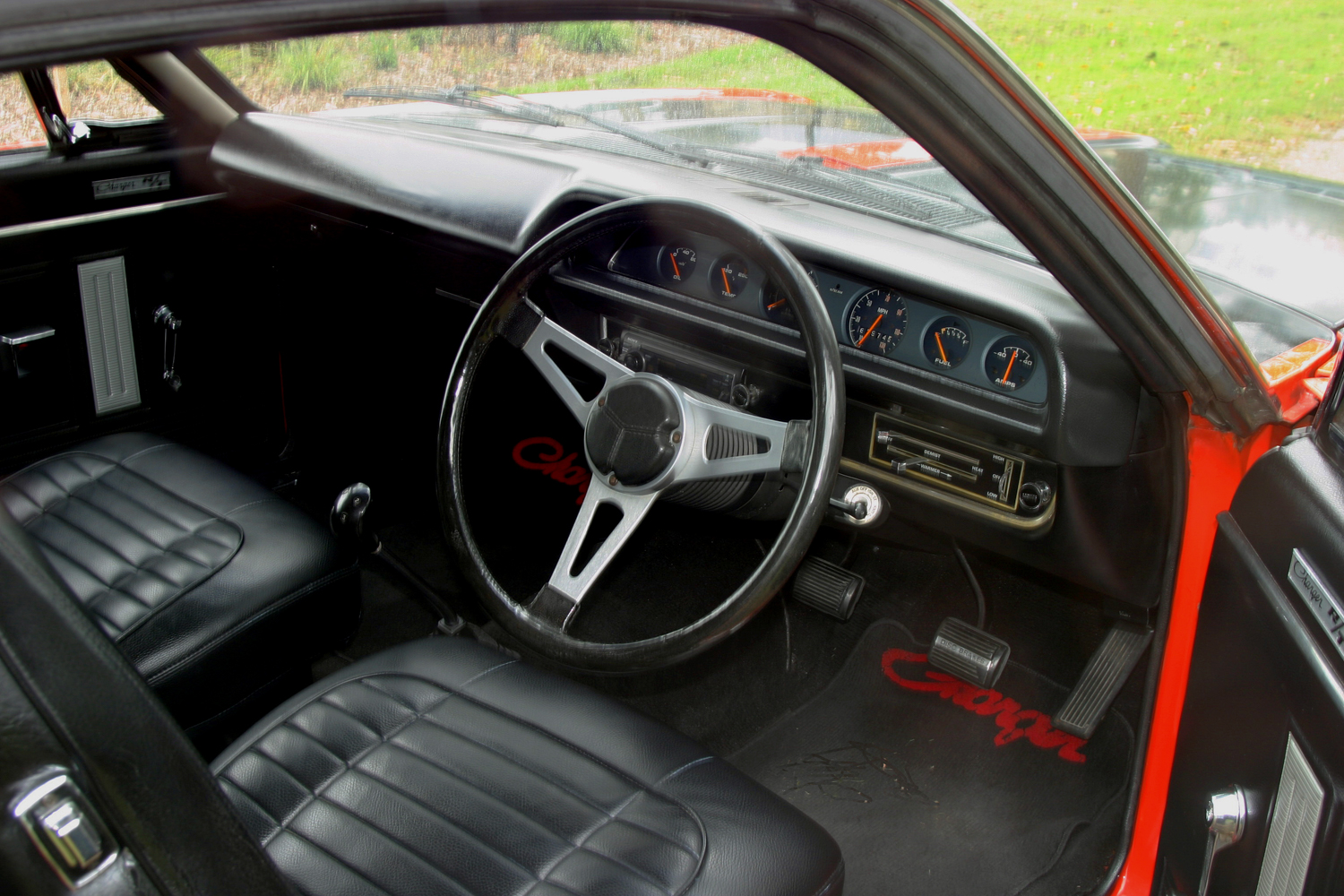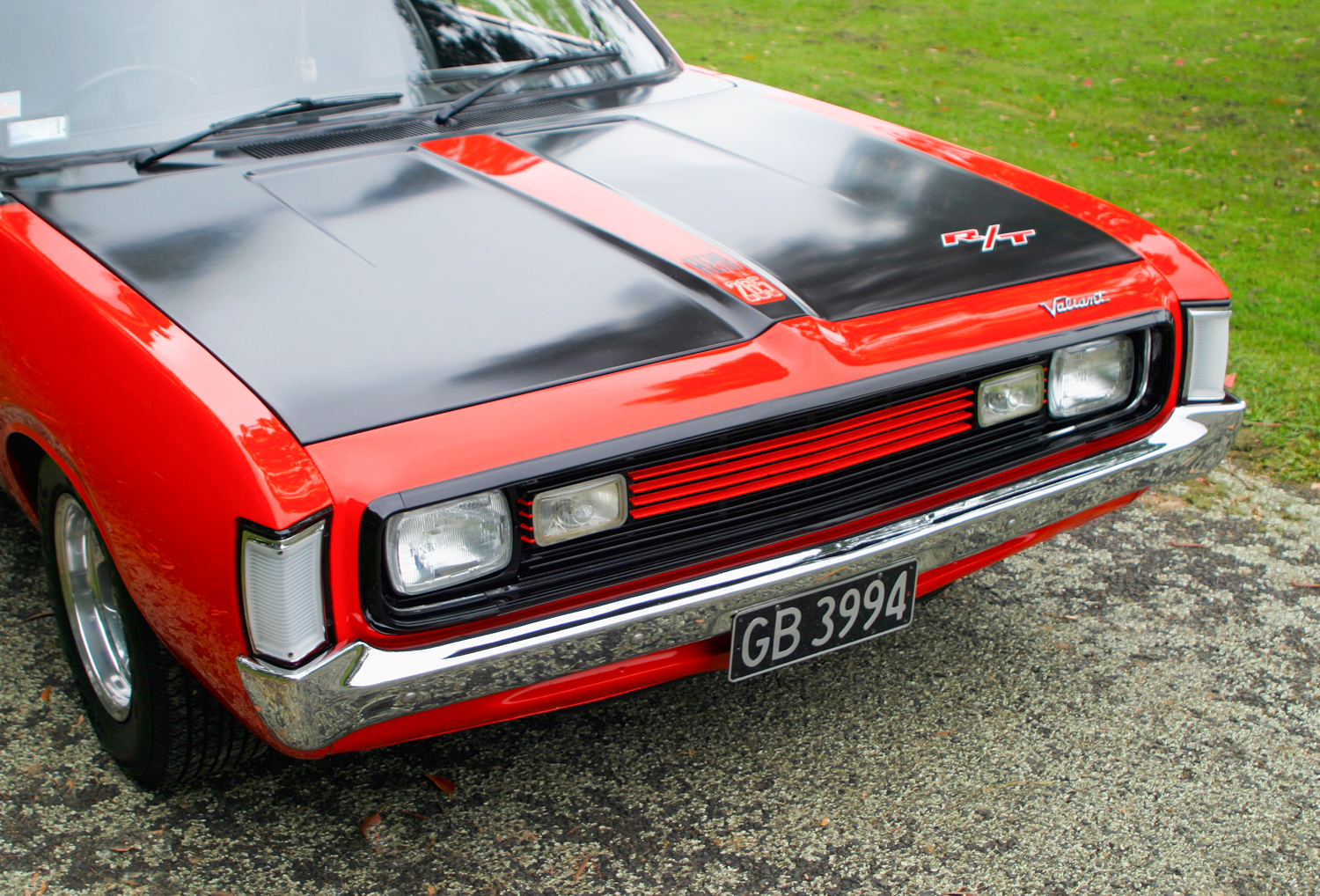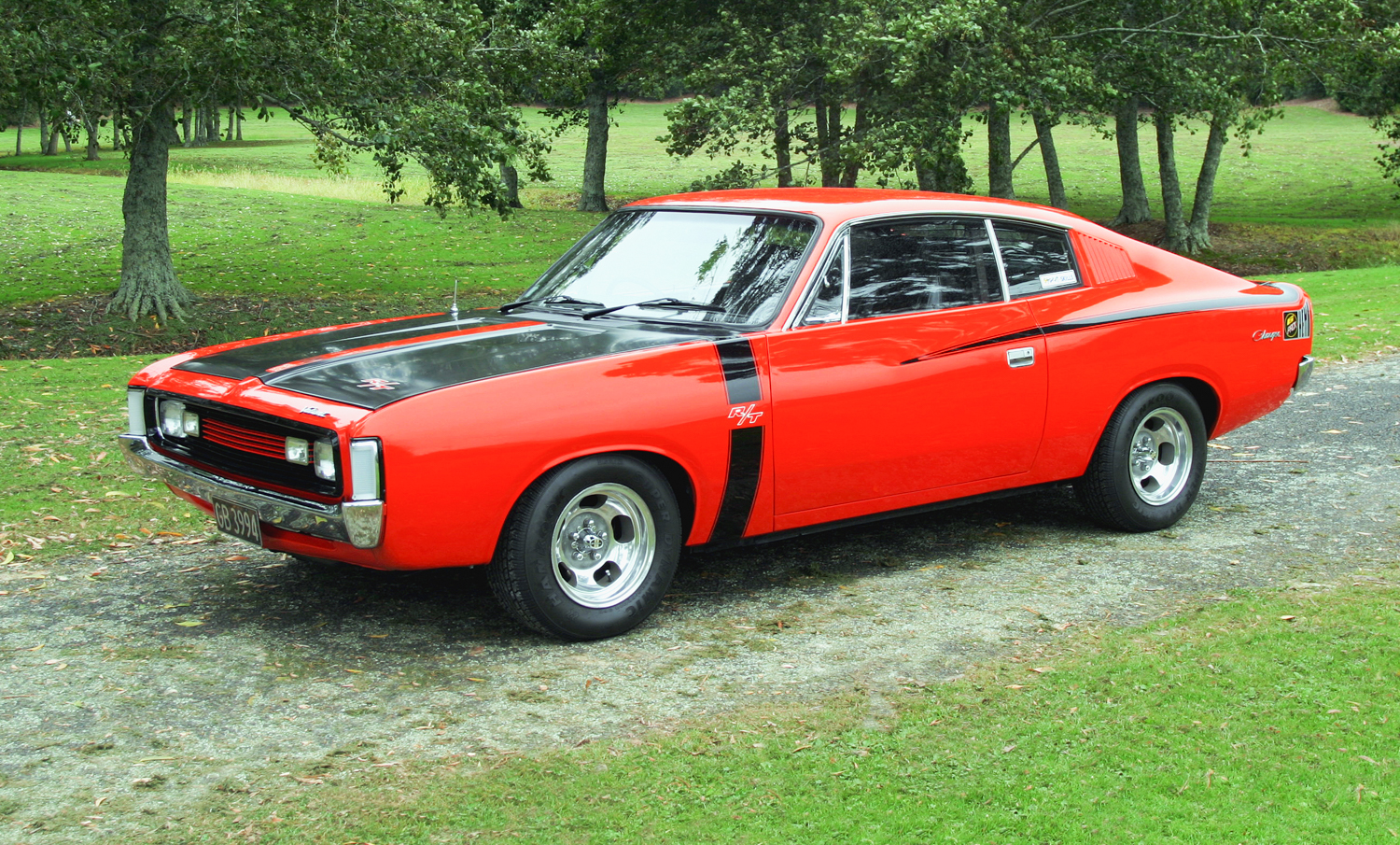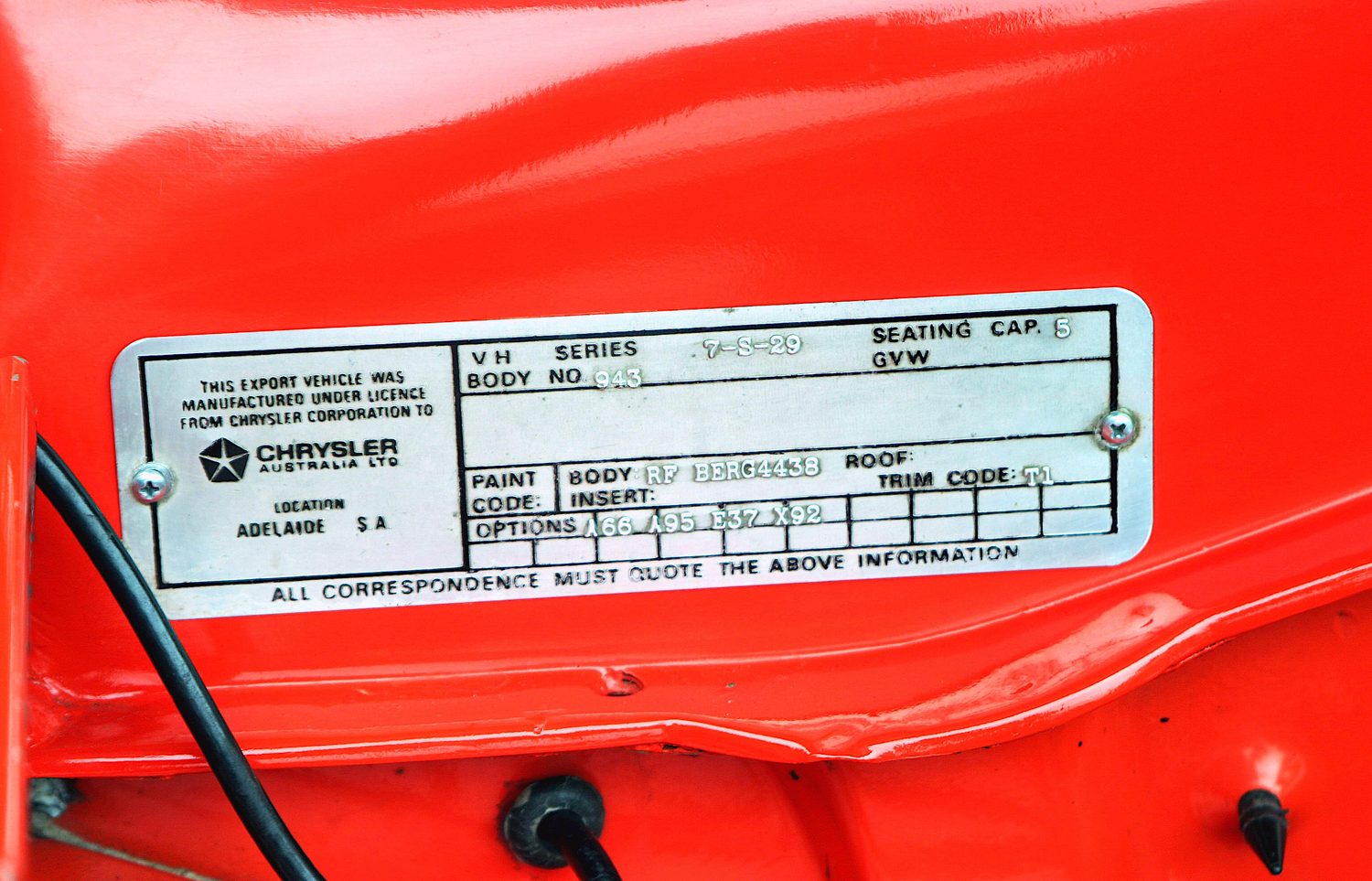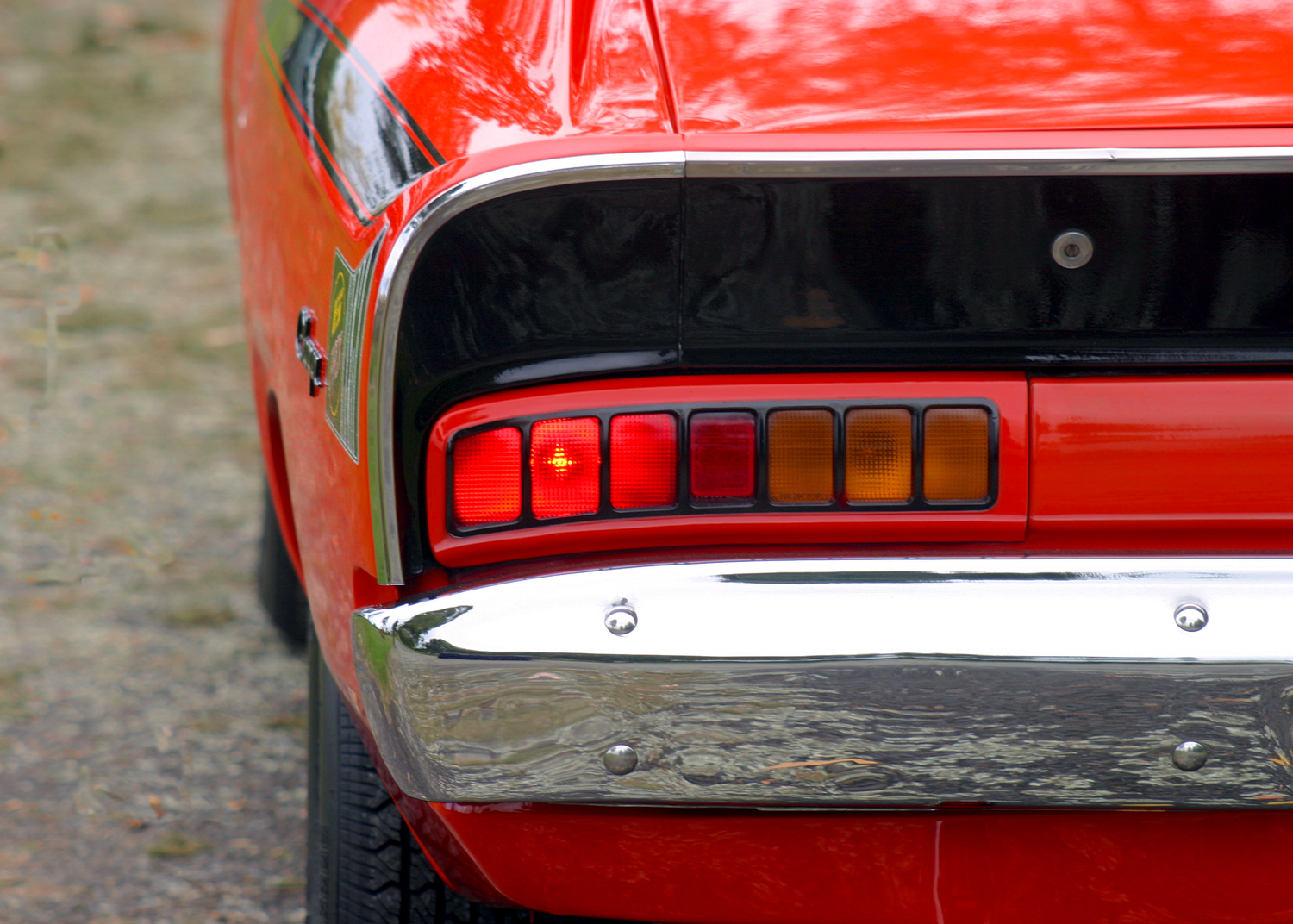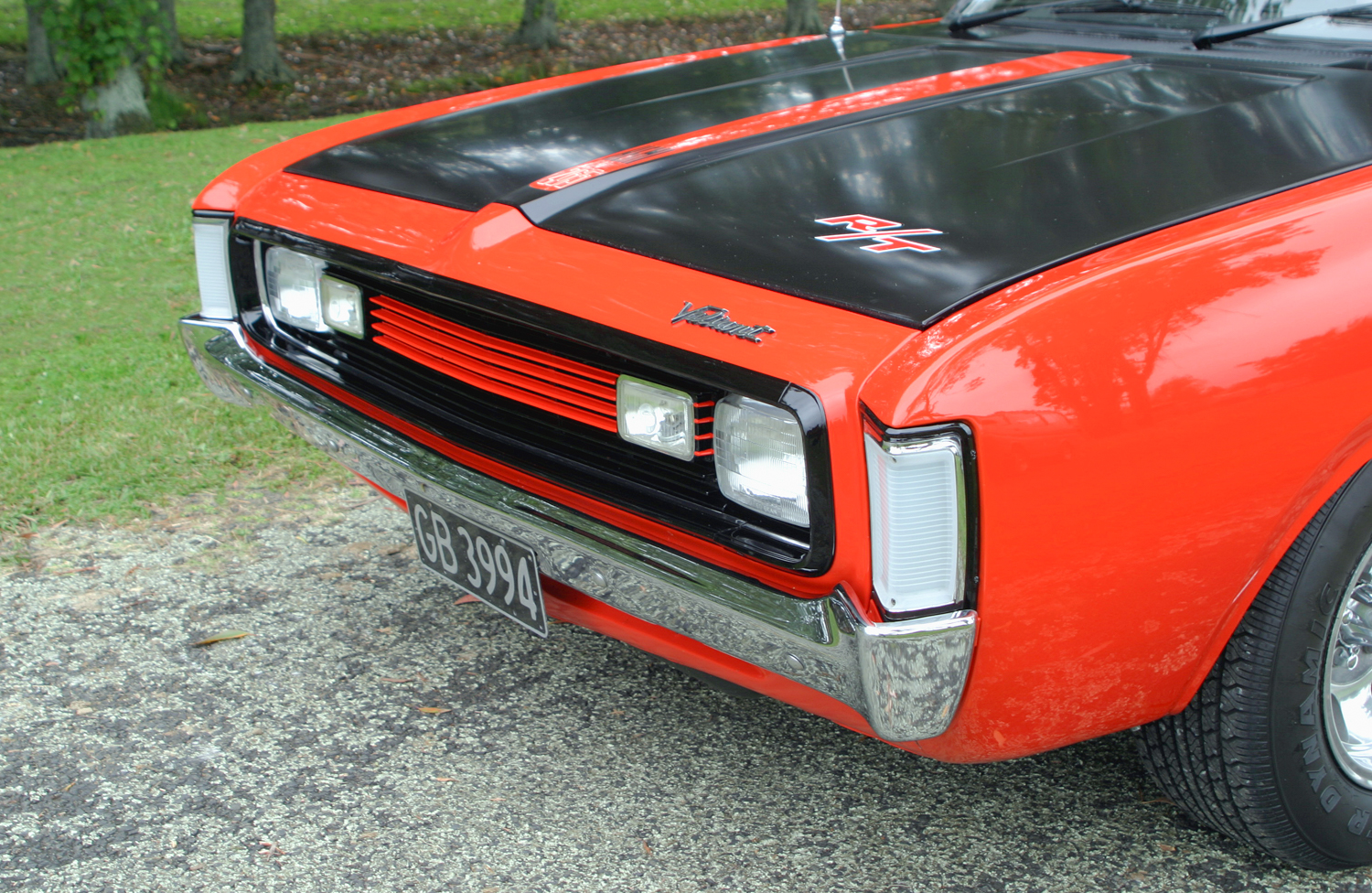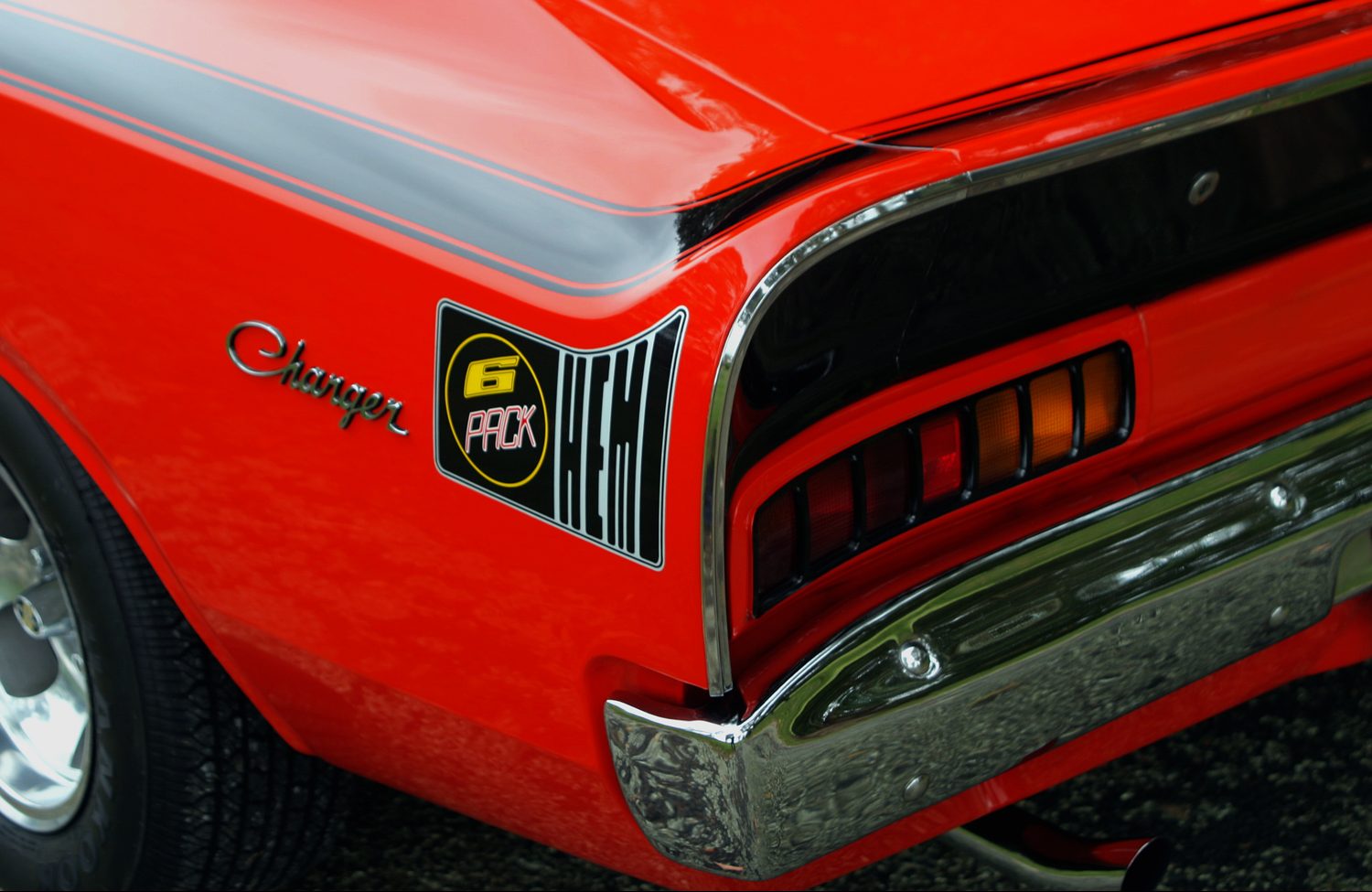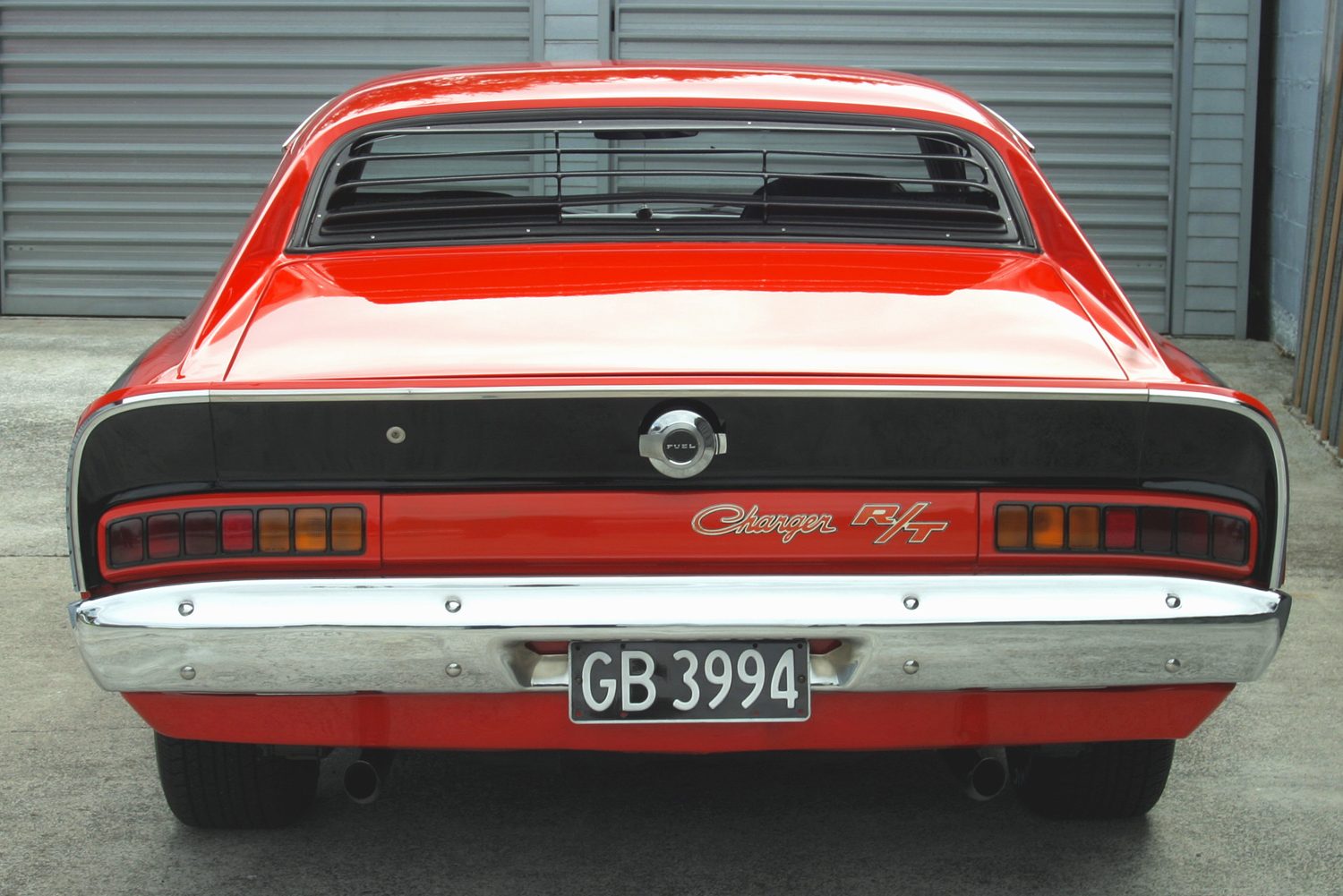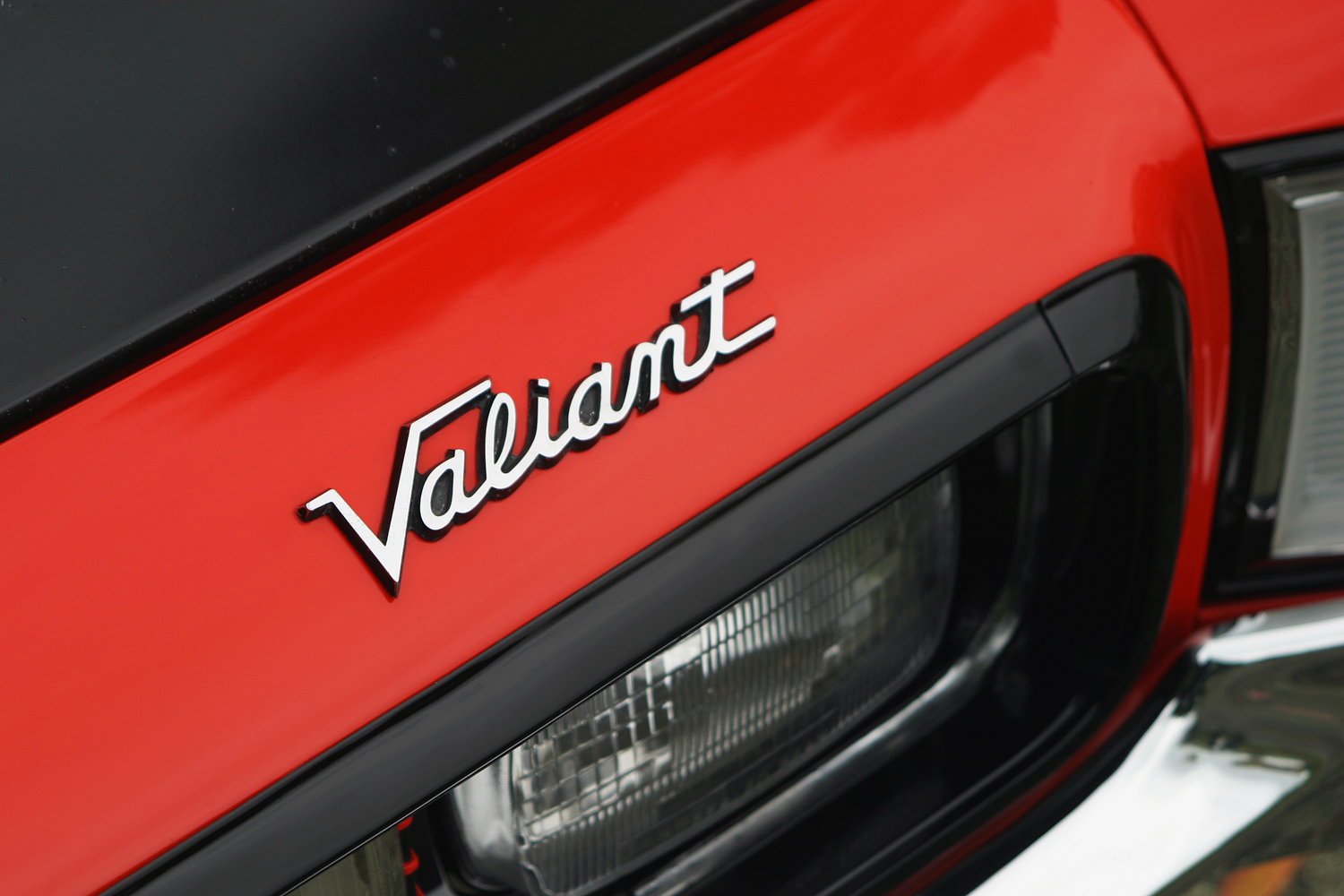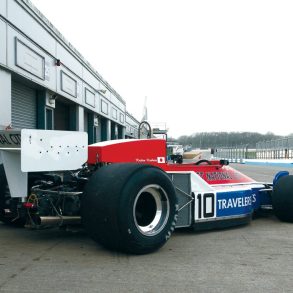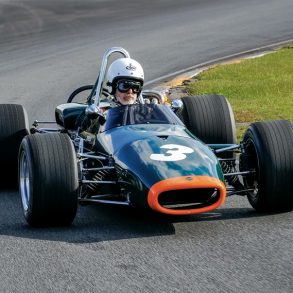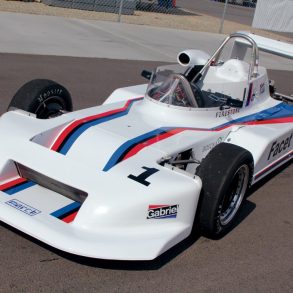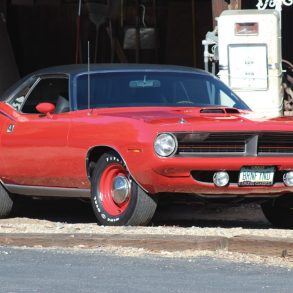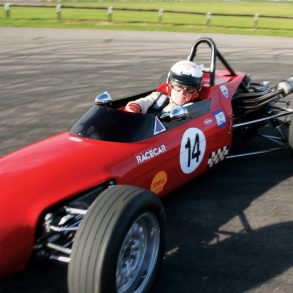
I discovered that the little island nation of New Zealand is a prosperous jewel of a country containing a lot of car buffs. A fellow named Mike Goodhue from the city of Hamilton had his immaculate Australian Charger RT on display there and agreed to let us take it for a spin and photograph it later in the week.
When we arrived, after the usual “howdy do’s” I climbed into Mike’s ‘71 Valiant Charger RT Six Pack Hemi E37 and eased it down the driveway and into the street. Its engine muttered softly in that mellow rumble only a high performance inline-six can produce. The sound is sort of like that of a D-Type Jaguar from the ’50s.
When we get to the edge of town where it spills out onto a nice country lane, I pull the car into low, gave it throttle and ease out the clutch. I am not up to truly flogging such a rare classic (only four of this model exist in New Zealand) so there is no tire smoke, but the sporty Mustang-sized compact takes off like a jet fighter from a carrier deck.
The acceleration is truly neck snapping, with tons of torque through the bottom and mid-range, and coming into its own as the engine gets up on its cam. I hit an almost instant 60 in first gear, and second got us to 90 in no time. Top end in third is 132 mph but I backed off well before that so as to avoid the long arm of the law. The little orange Charger is balanced and nimble with its Mopar torsion bar front suspension. In addition, its front disk, rear drum brakes are excellent for 1971.
This 1971 Charger RT E37, of which only 134 were built, is the better behaved street version of the E38 that was developed for racing in the Bathurst 500, Australia’s premiere production car event. Both cars were equipped with a performance tuned, seven-main bearing, 265 cubic inch, inline-six derived from a motor that Chrysler Australia originally intended for commercial vehicles. However, this humble Hemi head six was carefully re-engineered to produce 280 horsepower at 5,000 rpm and 318 ft/lbs of torque at 3,700 rpm in full racing trim that year.
The street version E37 we tested produces a slightly tamer 248 horsepower at 4,800 rpm and 306 ft/lbs of torque at 3,400 rpm, running a 9.7:1 compression ratio and pump gas, but still accelerates like a rocket thanks to its inline engine offering usable torque superior to that of most V8s of the same displacement. Both street and racing versions of the Charger RT Six Pack came equipped with a locally built three-speed manual transmission in 1971, because Chrysler Australia was operating on a limited budget and trying to make their new Australian muscle car out of locally produced components.
And then 1972 saw the introduction of the E48 and E49 Charger RTs that sported four-speed Borg Warner gearboxes and even hotter versions of the 265 cubic inch Hemi six. These cars never managed a win at Bathhurst (Australia’s equivalent of the Indy 500 in terms of popularity) against the Ford Falcon GTHO 351 V8 cars and the Holden Monaros (General Motors) with their 327 small-block engines, but they did earn a third place after a long pit stop ended their chances for outright victory.

The V8 Falcon could only manage 0-60 in 6.4 seconds, but the E49 Charger could do it in 6.1, and while the Falcon’s damnedest was 0-100 in 15.2 seconds, the six-cylinder Valiants could do a ton in 14.1, more than a second faster, thus eating the V8s alive. Also, in its day the E49 could run a 14.7 in the quarter mile, but on modern tires a full second was shaved off of that by an American collector who imported one of these cars to the United States a few years ago.
How it Happened
As far back as the 1920s, Chrysler automobiles had been imported into Australia. And then Chrysler Dodge DeSoto Distributors was formed in 1935 by sales agents who imported all three Chrysler brands as well as Plymouths. They came into the country as chassis and bodies were added by coachbuilders such as T.J. Richards and Holden, who built bodies for many makes of cars before they devoted themselves exclusively to General Motors.
And then in 1951, Chrysler bought controlling interest in the distribution company and named it Chrysler Australia Ltd., intending to manufacture a range of cars with 90% local content. Soon thereafter they started assembling American-designed cars based on Plymouths and Dodges, initially introducing models called the Royal and Phoenix.
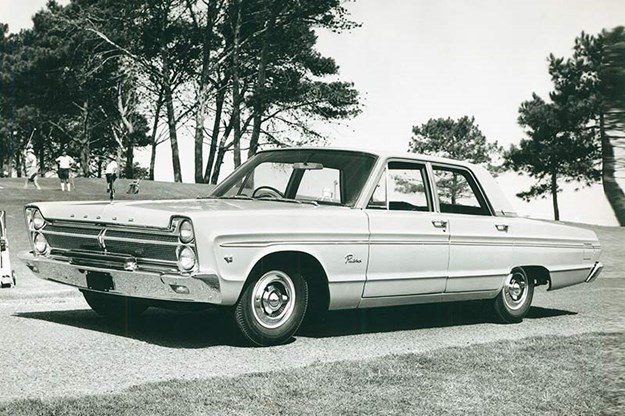
The Royal and Phoenix were similar to the American Plymouths and were tough and durable. As a result they became popular as taxis, using flathead, six-cylinder engines that produced just 115 hp. But around 1960 the company began introducing new Forward Look styling, push button automatic transmissions and slant-six as well as V8 powered models.
During the 1960s and 1970s, Chrysler went on to make a substantial investment in Australian manufacturing facilities, and produced a number of Australian models. This continued until the manufacturing facilities were sold to Mitsubishi Motors, in Australia, in 1980. Today, FCA (Fiat Chrysler Australia) the official Chrysler subsidiary in the country, act as distributors for Chrysler, Jeep, Dodge, Abarth, Alfa Romeo and Fiat.
Chrysler was always a much smaller operation in Australia than Ford or General Motors. In 1969, their offerings were mostly large family sedans that appealed to mature audiences, or farmers and ranchers looking for comfortable family transportation. But then Chrysler saw that they were loosing the younger market to their competitors, and that a sporty car, and a win at Bathurst, would change all that in a hurry. Trouble was development funds were severely limited. That’s why they chose their torquey Hemi head sixes designed originally for trucks to do the job.
At first, Chrysler wanted the designers to use a single Carter four-barrel carburetor on a long, Hyper Pac ram-type intake manifold similar to those used on their slant sixes, but tests revealed that this configuration offered poor mixture distribution, and a terrible response to lateral acceleration. In fact, tests proved this set up so unsatisfactory that the engineers finally decided to try the engine with three two-barrel Webers on it.
To avoid suspicion from the other manufacturers, each Weber was purchased from a different source. The resulting configuration produced much more power, but had rather poor low rpm characteristics, so a complete Charger was packed off to Italy to the Weber factory to let them sort out the problems. What resulted was a smooth powerful, torquey motor that made the Valiant Charger RT Australia’s fastest accelerating production car for 27 years and the most powerful production six of the time.
The pistons in all of the RT Six Pack engines had full floating wrist pins, and the crankshaft, connecting rods and valve springs were shot peened to improve fatigue resistance. Premium quality bearings were used throughout, and the engines were carefully balanced and meticulously blueprinted. A large, high quality vibration damper was also added to make the engine smooth and to protect the long crankshaft from torsional loads under acceleration.
The resulting horsepower and torque figures may not sound terribly impressive to an American big block muscle car buff these days, but when you put such a light, powerful engine in a little unit-bodied Aussie Charger weighing a mere 3,090 pounds, it makes quite a potent package. In fact, the Valiant Charger RT was the fastest six-cylinder production car of its era, and the fastest accelerating Australian built car of all time.
Hemi engine buffs are quick to claim that the 265 Charger engine is not a “true” Hemi because the spark plugs do not come down from the top, and the engine does not have a cross-flow head; but in fact the combustion chambers are hemispherical, with the valves lined up along its length and tipped to follow the contours of the chamber. The intake manifold sits high on the engine to allow the straightest path for the fuel/air mixture, and a carefully worked out, tuned extractor exhaust helps make for very efficient breathing.
Chargers were also built using the larger Chrysler 318 V8 motor, but because these engines were 300 pounds heavier, necessitating more weight elsewhere in the car, performance was not improved. In fact, statistics from the V8-powered cars were discouraging because they were virtually identical to the Hemi six cars.
The sporty, handsome styling of the Australian Chargers was the work of American designer Bob Hubbach, who also came up with the American Dodge Charger Daytona. He then went on to create such exciting designs as the Dodge Viper and the Plymouth Prowler, as well as the Chrysler Atlantic concept car, which was a knock off of the Bugatti of the same name, and also the Dodge Copperhead show car. Hubbach did his initial sketches for the Valiant in 1969 in the United States, and then, along with Chrysler Australia’s design team, managed to come up with the final concept in just a matter of days.

A full-size clay mock up was presented in February of 1970, complete with the recessed back window and the signature rear spoiler reminiscent of the American Charger Daytona. The result was one of the cleanest, sportiest looking Chrysler products ever. In fact, in this author’s opinion Mopar’s classic muscle car styling works even better on these smaller cars than it does on its larger American counterparts.
Chargers were available in a number of bright colors such as Hemi Orange, Hot Mustard, Magenta, and Vitamin C, but silver was also offered for those wanting a more sedate package. And with the black hood and trim accents, these cars were very handsome indeed. The decals and trim on the car are similar to Mopar’s other muscle car offerings, with the exception of the center of the grille, which was always Hemi Orange.
The E37 featured here is an all original car in immaculate condition, and is a rare and much sought after vehicle in the land down under, as well as the land down under the land down under, i.e. New Zealand. Most Chargers were raced, altered and crashed over the years, so original cars are hard to find today. As we drove around town, heads turned and we were given the thumbs up by fellow car buffs who were glad to be able to see and hear this vintage true Six Pack run.
Many base-model Chargers with only a single carb have been upgraded to the RT package, but their build plates betray their humble beginnings. We were able to confirm that Mike Goodhue’s E37 is the real thing though, thanks to a beautifully presented, well written book on the Australian Chargers called “Hey Charger” by Gavin Farmer and Gary Bridger. It’s out of print now, but you may be able to find it at used book dealers.
The usual definition of a muscle car typically includes a V8 of American origin, but these little Chargers from Australia could certainly hold their own with many of America’s best efforts. The old adage that “There is no substitute for cubic inches” generally holds true, but it omits a couple of other important determining factors which are the power to weight ratio, and usable rear wheel horsepower. Inline sixes can potentially produce more usable rear wheel power than equal displacement V8s. And big, heavy engines require big, heavy cars.
Many proud owners of Falcon and Holden V8 powered Aussie muscle cars in the land of the great outback have had their noses tweaked by these compact Mopar screamers. Sadly, most of us in the United States will never have an opportunity to see one of these Down Under muscle machines strut its stuff. I know that if I ever find one for sale at a price I can afford when on a trip to the Southern Hemisphere, I will be sorely tempted to bring it back home with me.
Specifications
| Body style | Two door sport coupe |
| Length | 179.9 inches |
| Width | 74 inches |
| Wheelbase | 105.1 inches |
| Height | 53.9 inches |
| Weight | 3090 lbs |
| Engine | 265 cubic inch inline six, Triple dual throat Weber carburetors |
| Power | 248 Horsepower at 4,800 rpm |
| Torque | 306 ft/lbs of torque at 3,400 rpm |
| Compression | 9.7:1 |
| Transmission | Three-speed manual |
| Clutch | Dual plate dry |
| Rear axle ratio | 3.50 or 3.23:1 |
| Brakes | Disc/finned drum |


